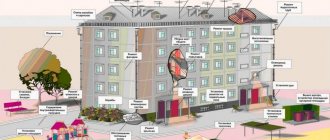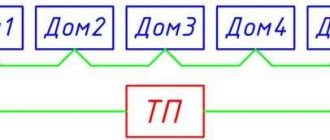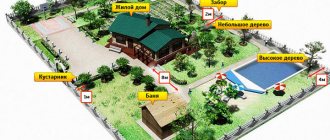According to current legislation, each multi-apartment building has its own adjacent territory. It is designed for the comfort of home residents, the arrangement of sports and children's playgrounds, recreation areas, parking lots and other infrastructure. And if earlier the municipal authorities and developers were in charge of the arrangement issues, today the initiative passes to the apartment owners.
One of the initiatives is the installation of fences in the local area to protect against strangers and restrict the passage of vehicles. Below we will consider the legal difficulties in resolving this issue, we will provide useful tips and instructions for action.
Position of the law
According to the law, the local area includes a house, a plot of land around an apartment building, as well as the property located on it. The owners of apartments and commercial real estate in the building act as property owners. A prerequisite for the local area is to comply with the current norms and design rules. A full definition of the term can be found in the Land Code of the Russian Federation (Article 36).
Apartment owners have the right to do the following:
- using the capabilities of the local area and the structures located on it
- installation of fences
- construction of sports and children's playgrounds
- arrangement of parking lots, etc.
Issues related to the local area are considered in the Land Code of the Russian Federation, the Housing Code of the Russian Federation, as well as two Resolutions (of the Plenum of the Russian Federation and the Arbitration Court of the Russian Federation) numbered 16 and 22, respectively.
Free legal consultation >>
Agreement process
The prepared project is submitted for approval to the following authorities:
- Authority for architecture and urban planning.
- Regional branch of the Ministry of Emergency Situations.
- Local branch of the Ministry of Internal Affairs.
- Emergency medical station.
The next stage is choosing a contractor. Money for the installation of fencing can be received directly from the residents themselves or deducted from funds contributed for the repair of an apartment building and its improvement.
When constructing a fence, the following requirements must be met:
- should not create obstacles for the access of ambulances, fire brigades and other emergency services;
- should not interfere with the rapid evacuation of persons in the house;
- if necessary, can be dismantled (in case of repair of underground communications);
- should not interfere with access to communication systems (water supply, telephone and electrical cables);
- cannot disrupt pedestrian connections (block pedestrian paths, sidewalks);
- should not restrict access to other buildings.
This is important to know: Real estate tax for legal entities in 2020
Municipal authorities may establish additional requirements:
- the height cannot exceed 2 m (for sports and children's playgrounds up to 3 m);
- transparency must be at least 50%;
- the fence must be made of metal material;
- The presence of sharp protruding parts is excluded.
Methods for fencing a site
According to the law, homeowners in a multi-storey building have the right to take measures aimed at protecting the local area from animals, strangers and foreign cars, as well as vehicles using the road as a bypass.
To avoid the problems discussed above, you can use fences that can have different purposes:
- Complete access denial. There are two types of structures: lawn or stationary. In the first case, bushes are planted, thanks to which access to the territory is limited. The height of vegetation rarely exceeds 50-60 cm. Despite its external beauty, this fencing method is rarely used due to maintenance problems.
In the second case, fences made of stone or metal are used. The finished fence can have a height of up to 200 cm. Profiled sheets are often used, which have an affordable price and are easy to install. The height of the fence is agreed upon at a general meeting, taking into account the residents’ goals. If the goal is to close the area to outside traffic, you can install a fence up to 20-30 cm high.
High fences are rarely installed and are in demand among residents of luxury new buildings. An intercom is installed at the gates of such structures, and the entrance to the building is controlled by a concierge. Its task is to let residents of the house through, as well as other service providers.
- Partial access blocking. A common situation is the installation of a barrier that prevents unauthorized cars from entering the local area. At the same time, people's access is not limited in any way. To install such a limiter, the consent of the residents of the house, as well as approval from emergency services, is required.
- Restriction of access to part of the territory. In order not to fence the entire site, a decision is made to protect the playground, parking lot or other element of infrastructure. A common solution is to install a fence up to 2-3 meters high. Car tires can be used to save money.
- Closing specific objects. Such fences are installed by utility services to restrict people’s access to any structure or area under repair. Such fences are temporary and are most often made of wood.
Most fences in the local area require official registration and approval. Violation of this rule entails dismantling the structure and administrative liability.
How to fence the local area of an apartment building, types of fencing
There are several types of fencing.
Complete access ban
It is possible to completely enclose an area near a residential building using a dense hedge, stone or metal fence up to 2 m high. Shrubs are used infrequently because they are difficult to care for. In addition, this method does not protect well from the entry of strangers and only blocks the way for vehicles.
Installing a fence provides better protection. The advantage of this choice is the low cost of the fence.
Full fencing is often used in new houses that have an intercom with a video surveillance system and a watchman. In such a situation, those living in the house will easily get inside, and it will become difficult for outsiders to enter the yard. The disadvantage of such a system is the need to regularly pay for the work of the security guard.
Partial access denial
To partially restrict access to the territory, a barrier is used. This method works well to prevent unauthorized entry of vehicles into the local area. It is not difficult to obtain permission to install. But you will need to coordinate the appearance of the barrier with the police, firefighters, and ambulance.
At the same time, strangers can easily enter the yard. The barrier will also be useful for homeless animals.
Partial ban on access to part of the local area
Such fences are called “target” fences. They can be installed without special permissions or approval. Most often, a metal mesh fence is used as such a fence. Its height is rarely more than 3 m. Such options are used to limit access to garbage containers, a playground or a football field.

To prevent vehicles from parking in the playground, you can use car tires. Such a fence additionally performs an aesthetic function. It is recommended to install flower beds inside tires. This way the fence will look more original.
Denying direct access to a specific object
Most often, such variations are used by public utilities. During repairs or construction, access to some object is blocked by temporary structures made of boards. With the help of such measures, it is possible to ensure the safety of bystanders and prevent children or teenagers from entering dangerous territory.
Who has the right to erect fences?
The adjacent territory includes the building itself, the land plot located near it and infrastructure facilities that are necessary to ensure the operation of this structure and the comfort of its residents. The owners of the land plot and property are considered to be the owners of the apartments in the building, therefore the decision to install fences in any shape or form is made only at a general meeting.
The consent of the apartment owners is drawn up in the form of a written protocol indicating the names, signatures, date of the event and other data. The legality of the decision made depends on the number of participants. The higher the percentage of approval, the higher the legitimacy of the protocol. The minimum threshold is 2/3 of the total number of residents. Lack of approval and unauthorized installation of fences is considered illegal.
general information
Each high-rise building is documented to be associated with the land plot on which it is located. The plot is already registered and has a cadastral number. The boundaries of the site include not only the land located directly under the house, but also sidewalks, roads, playgrounds, and green areas. It is this area around the house that reveals the concept of “adjacent territory of an apartment building.”
According to the rules for maintaining common property, the adjacent territory of an apartment building is: [important] The adjacent territory includes:
- a plot of land under the house;
- landscaping and landscaping elements;
- sports and children's playgrounds;
- parking lots;
- fire passages;
- boiler rooms;
- transformer substations;
- other infrastructure facilities.
The exact boundaries of the local area of an apartment building and the area of the land plot are reflected in the cadastral passport ; this information is publicly available - on the public Internet map of Rosrestr. The status of the plot can also be found on the map - it is either rented by the HOA or registered as the property of the residents.
The adjacent territory, in accordance with Article 16 of the Law “On the Enactment of the Housing Code,” belongs to all apartment owners on the basis of shared ownership . And if it is rented, then ownership rights can be registered if such a decision is reflected in the minutes of the general meeting. The shares of the land plot are determined between all residents in proportion to the areas of their apartments, as well as all common property in the house.
This is important to know: Validity period for apartment assessment
Privatization of the local area of an apartment building is free and does not require registration by each owner. Based on the analysis of the legislation, when the owner buys an apartment, he also buys part of the common property, which is not subject to division , therefore we can assume that the registration of the share was carried out at the time of registration of the right to the apartment.
How to install a fence legally
To avoid negative consequences, demolition and administrative penalties, you must follow the instructions for installing a fence in the local area.
Algorithm of actions:
- Gathering of apartment owners to discuss the issue. After the meeting, minutes are drawn up indicating all participants. People who approve the innovation sign the document. During the meetings, a person is also determined who will contact the authorized structures and coordinate the project.
- Submitting an application for land surveying, protocol and necessary papers to the authorized body.
- Waiting for the results of calculating the area and indicating the boundaries of the storage area.
- Registration of the site in Rosreestr.
This is the first stage that allows you to determine the boundaries of the site and register it as property. In the case of new buildings that were put into operation after 2005, the necessary documents must be available. After processing the request, representatives of Rosreestr issue the following documents:
- cadastral passport and extract with information about turning points
- an act indicating the turning points of the local area.
This documentation is used to determine the location of the fence and to avoid going beyond the legally established area.
Registration of ownership of a local area
The legislation obliges, before erecting any enclosing structure on the territory, to first hold a general meeting of the owners. Only with the consent of the majority of people living in the building is it possible to install fencing structures. At the end of the meeting, a protocol is drawn up, which is one of the main documents when applying to municipal authorities. To install a barrier, it is necessary to coordinate all actions with the municipality and emergency services.
First of all, residents need to make sure that they have ownership rights to the area around the apartment building. In new buildings commissioned after 2005, land rights are usually transferred along with the apartment. For owners of older multi-apartment buildings, the registration procedure is as follows:
- carry out land surveying - establishing the boundaries of the territory (it is necessary to prepare an application and protocol for the collection of owners);
- registration with the cadastral service;
- transfer of a package of papers to Rosreestr.
After registration of the adjacent plot, those living in the house become shared owners of the land. Next, you can proceed to collecting documentation directly for the construction of the fence. The installation of a structure is absolutely legal.
Approval issue
Discussion of the issue of installing fences between apartment owners is only the first stage. Restricting free access requires coordination with other authorities, namely the law enforcement agencies of the Ministry of Emergency Situations, the State Traffic Safety Inspectorate, the ambulance service and the department dealing with issues of urban planning and architecture. Obtaining approval from the mentioned structures is inevitable, and especially if we are talking about installing a barrier or a stationary fence. If any of the emergency services refuses approval, the constructed structure may be demolished by order of a judicial authority.
To obtain a positive decision on installing a barrier, the following requirements must be met:
- Installing a security booth next to the fence and hiring personnel to be on duty around the clock.
- Attaching a sign with telephone numbers of citizens who can quickly open the barrier using a remote control or using a key.
As for fencing small areas, for example, a parking lot, playground or other infrastructure, the approval of 67% of apartment owners or more is required. If any of the owners ignored the fees, he will have to comply with the general decision (if the required number of votes was received).
Coordination
After preparation, the plan for all work must be agreed upon with such services as:
- Ministry of Emergency Situations, namely with the local administration of this service.
- The police represented by the leadership of the local department.
- With the ambulance service that operates in the area.
- With architectural and construction type inspection.
If residents do not take this condition seriously and do not coordinate their actions with the above services, then one of them in the future may be offended and file a lawsuit in court.
If the residents fail to prove that the work was coordinated, then the judge will undoubtedly side with the plaintiff and decide to liquidate all previously completed work. In other words, everything that was built will be automatically demolished by court decision, and the money that was collected from the tenant will be thrown away.

As a result, we can conclude that no one prohibits residents from fencing the territory themselves and all their actions will be absolutely legal if they adhere to a certain procedure, which is prescribed above.
This is important to know: Claim against the management company for flooding an apartment
The services mentioned above can go to court not only because they are offended.
The fact is that they also have their own responsibilities and in order for them to be able to fulfill them fully in a fenced area, approval is required.
What to do in case of refusal
It is foolish to assume that emergency services will be delighted with the innovation and will immediately give permission to install fencing for the local area. Authorized bodies often take the innovation with hostility and refuse to approve the project. In this case, it is necessary to support the application with official documents from Rosreestr and justify the need to install a particular fence. If emergency services are guaranteed unhindered access to the territory, there will be no problems with approval.
How to challenge an “extra” fence
The installation of unapproved fences or other types of fencing in the local area is prohibited by law. If this rule is violated, apartment owners can protect their own interests.
The algorithm of actions is as follows:
- Determining the legality of an object. To do this, documents are requested confirming the possibility of including the adjacent plot in the cadastral plan. It is necessary to study the minutes of the meeting, which must contain more than 2/3 votes in favor. If this condition is not met, the design is illegal.
- Resolution of the issue at a meeting. If an illegal building is identified, the apartment owners gather again to decide on further actions - legalization or liquidation.
- If a decision is made to remove the object, an application is submitted to the Administration, which indicates the address and cadastre number and a photo of the barrier. The document specifies the requirement to remove the illegal object.
If a positive decision is made, the structure will be dismantled within a month.
What awaits violators?
Unauthorized installation of fences is illegal. If at the meeting there were no 2/3 votes for the installation of the fence, or the design was not agreed upon by the services mentioned above, violators will face consequences. The reason is obvious. Deviation from the requirements of the law can lead to tragedy. For example, the ambulance will not be able to respond to the call, and the person will die. Or a fire will start in one of the apartments, and the fire brigade will not get to the house to extinguish the fire.
In most cases, the problem is solved by demolishing the illegal structure, but administrative punishment in the form of a fine is possible. In this case, all residents who make an unlawful decision bear responsibility.
Cost of issue and possible difficulties
During the meeting, you need to discuss the costs that are expected when arranging the local area and installing fences. On average, the price of 1 linear meter of fence in 2020 is 1,700-1,900 rubles. The installation of swing gates will require another 35-40 thousand rubles. If you make a sliding structure, it will cost even more - from 55 thousand rubles or more.
When calculating costs, the type of work, the length of the fence, the type of barrier and the number of gates are taken into account. It is also necessary to take into account the employee’s remuneration when organizing round-the-clock duty. Additional costs include installation of an intercom.
Once the costs are determined, another challenge arises—trying to raise money for the innovation. Apartment owners who refused to install fences do not agree to spend money. There is no provision in the law that would force owners to contribute funds. Even if a person took part financially in the collection, he must be given a key or told the intercom code.
According to the requirements of the Civil Code of the Russian Federation (Article 209), the owner of an apartment has the right to dispose of personal property, and creating obstacles is considered a violation of the law. Owners of commercial establishments based on the first floors of the building may oppose the installation of a fence. It is not beneficial for them to limit the flow of people, because this scares away new customers. In this case, the owner of the store or salon can sue and demand the demolition of the fence. To avoid conflict, you can agree and leave free access to commercial facilities.
Installation of fences on the territory of the house
The construction of any fence should not impede the passage of special vehicles and free access to residents of the house.
Such measures help prevent damage to residents’ recreation areas, children’s and sports areas installed in the area adjacent to a multi-apartment residential building, and also improve the safety of residents. However, unauthorized construction of fences is a violation of the law. It must be agreed upon between the owners, self-government bodies and emergency services.
If your house is older, then you need to carry out a land survey, which will determine the boundaries of the territory, and then put it on the cadastral register. After this, the owners of the apartments in the building automatically and free of charge become shared owners of the plot.
Typically, there are three main types of building structures used for fencing the local area of an apartment building.
It's no secret that utility services monitor the infrastructure of the house with their eyes closed. And enthusiasts, if there are any, quickly realize that their attempt to put the territory in order is not met with support. At least understanding from some people.
High fences are rarely installed and are in demand among residents of luxury new buildings. An intercom is installed at the gates of such structures, and the entrance to the building is controlled by a concierge. Its task is to let residents of the house through, as well as other service providers.
Lawyer Victoria Danilchenko, especially for Vesti.Nedvizhimost, gave step-by-step instructions on how to legally install a fence around an apartment building.
In the second case, fences made of stone or metal are used. The finished fence can have a height of up to 200 cm. Profiled sheets are often used, which have an affordable price and are easy to install. The height of the fence is agreed upon at a general meeting, taking into account the residents’ goals. If the goal is to close the area to outside traffic, you can install a fence up to 20-30 cm high.
First you need to identify the local area and clarify whose property it is. If you live in a new house built in 2005 or later, when the Housing Code of the Russian Federation came into force, then the local area has most likely already been formed.
Setting up a fence around your local area will help protect your yard from those who like to park on someone else’s property. This will also prevent noisy companies and those who like to leave garbage behind from entering the yard. But you can’t just shut yourself off from everyone. You must obey the law and act according to the established procedure.
Fencing an apartment building is more difficult. Town planning standards and fire safety rules must be observed.
Fences erected in the local area without proper registration must be eliminated as soon as possible.
Complete access denial. There are two types of structures: lawn or stationary. In the first case, bushes are planted, thanks to which access to the territory is limited. The height of vegetation rarely exceeds 50-60 cm.
At the moment, the issue of restricting entry into the territory of apartment buildings has been brought under the control of the prosecutor's office due to the increasing number of cases of illegal installation of fences.
According to Art. 36 of the Housing Code of the Russian Federation and Art. 16 of the Federal Law of December 29, 2004. No. 189-FZ “On the entry into force of the Housing Code of the Russian Federation”, the land plot on which an apartment building and other real estate objects included in such a building are located is the common shared property of the owners of the premises in the apartment building.
Moreover, in this conciliation agreement it is necessary to clearly stipulate what height and from what materials both parties agree to install the fence, and whether it will be solid or transparent.
After registration of the adjacent plot, those living in the house become shared owners of the land. Next, you can proceed to collecting documentation directly for the construction of the fence. The installation of a structure is absolutely legal.
Each of the above designs has its own characteristics and is intended for different types of restrictions.
Below we will consider the legal difficulties in resolving this issue, we will provide useful tips and instructions for action.
It is quite natural for residents to want to install fencing around the local area of an apartment building in order to prevent damage to the objects installed on it, as well as to increase their safety.
At the same time, according to the law, the residents themselves are obliged to take care of the territory adjacent to the house, regardless of whether their housing is privatized or not. Municipal authorities exercise control over management companies. In case of failure to fully fulfill the duties of cleaning the territory, residents are required to notify the management of the management company about this and draw up an appropriate report.
The legislation in force in 2020 provides for the mandatory holding of a general meeting of residents and obtaining their consent (with this fact recorded in the protocol) for the installation of these objects before installing any fences on the adjacent property.
Partial access blocking. A common situation is the installation of a barrier that prevents unauthorized cars from entering the local area. At the same time, people's access is not limited in any way.
At the meeting, you need to choose a person who will deal with the documents. Most often, they choose the person in charge of the house (if there is one) or the one who understands this and has free time.
At the moment, such fences have not yet become widespread, but are rapidly gaining popularity. This is especially true for those houses that have been put into operation recently and are intended for buyers with high incomes.
As we wrote in the material about allocating a plot for parking, residents of an apartment building can dispose of the adjacent territory only if it is allocated in the cadastre as a separate plot of land and registered as the common shared property of the residents.








